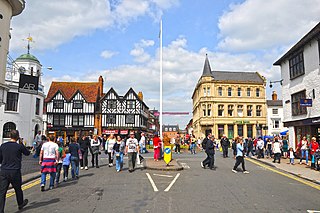
Stratford-upon-Avon, commonly known as just Stratford, is a market town and civil parish in the Stratford-on-Avon district, in the county of Warwickshire, in the West Midlands region of England. It is situated on the River Avon, 91 miles (146 km) north-west of London, 22 miles (35 km) south-east of Birmingham and 8 miles (13 km) south-west of Warwick. The town is the southernmost point of the Arden area on the edge of the Cotswolds. In the 2021 census Stratford had a population of 30,495.

The Royal Shakespeare Company (RSC) is a major British theatre company, based in Stratford-upon-Avon, Warwickshire, England. The company employs over 1,000 staff and produces around 20 productions a year. The RSC plays regularly in London, Stratford-upon-Avon, and on tour across the UK and internationally.

Warwickshire is a county in the West Midlands region of England. The county town is Warwick, and the largest town is Nuneaton. The county is famous for being the birthplace of William Shakespeare at Stratford-upon-Avon and Victorian novelist George Eliot,, at Nuneaton. Other significant towns include Rugby, Leamington Spa, Bedworth, Kenilworth and Atherstone. The county offers a mix of historic towns and large rural areas. It is a popular destination for international and domestic tourists to explore both medieval and more recent history.

The Lord Leycester Hospital is one of the best preserved examples of medieval courtyard architecture in England and is a charity supporting ex-servicemen. It is located in Warwick, England, next to the West Gate, on High Street. It is a Grade I listed building. The Hospital is a prominent and internationally famous feature of Warwick. For almost 900 years buildings have been erected and civic activity has taken place on the site, starting with the chapel built in 1126. The site was donated by the 12th Earl of Warwick in the 14th century to the United Guild of the Holy Trinity and St George. The Guild Hall, Great Hall and Master's House were constructed in the late 15th century. Over the centuries, the ancient buildings and 500 year old gardens have been admired by many famous visitors such as Charles Dickens and Oscar Wilde, by Kings and Queens, such as King George V and the Queen Mother and ordinary travellers from around the world.

The Guildhall in Leicester, England, is a timber framed building, with the earliest part dating from c. 1390. The Guildhall once acted as the town hall for the city until the current one was commissioned in 1876. It is located in the old walled city, on a street now known as Guildhall Lane. It was used first as the meeting place for the Guild of Corpus Christi and then later for the more formal Corporation of Leicester. The hall was used for many purposes, including council meetings, feasts, as a courtroom, and for theatrical performances; the ultimatum given to the city during English Civil War was discussed here. It is a Grade I listed building, and the surrounding area, also including the Cathedral of St Martin's, is a conservation area, one of three in Leicester.

The Grammar School of King Edward VI at Stratford-upon-Avon is a grammar school and academy in Stratford-upon-Avon, Warwickshire, England, traditionally for boys only. However, since September 2013 the school has admitted girls into the Sixth Form. It is almost certain that William Shakespeare attended this school, leading to the school widely being described as "Shakespeare's School".
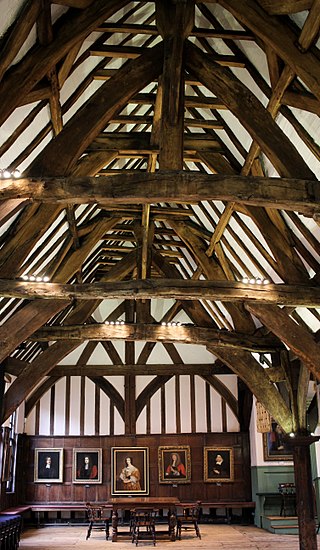
The Merchant Adventurers' Hall is a medieval guildhall in the city of York, England. It is a Grade I listed building and scheduled ancient monument.
Dr. Levi Fox OBE, DL, MA, FSA, FRHistS, FRSL, was the son of a Leicestershire smallholder. He became Archivist for the city of Coventry and then Director of the Shakespeare Birthplace Trust, and was a conservationist, local historian, and author.

The Guild or Gild of the Holy Cross was a medieval religious guild in Birmingham, England. It was founded in 1392 by three burgesses of the town – John Coleshill, John Goldsmith and William atte Slowe – in place of an attempt to found a chantry in the parish church of St Martin in the Bull Ring, that had been licensed ten years earlier but never came into effect.

The Guildhall is a historic building in Bore Street in Lichfield, Staffordshire in the United Kingdom. The guildhall is a Grade II listed building.
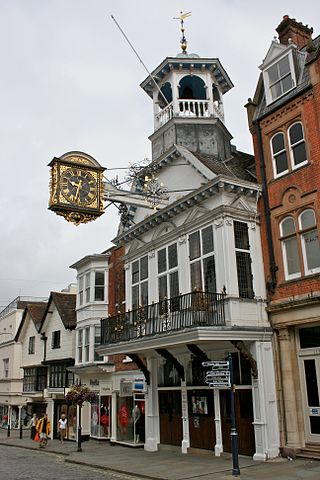
The Guildford Guildhall is a Guildhall located on the High Street of the town of Guildford, Surrey. It is a Grade I listed building.

Stratford's Historic Spine is the name given to a route in Stratford-upon-Avon along which many of the town's most important and historic buildings are sited, with many of the buildings connected to William Shakespeare. The Historic Spine was once the main route from the town centre to the parish church. It begins in Henley Street at Shakespeare's Birthplace and finishes in Old Town at The Holy Trinity Church and has buildings from the 14th up to the 20th centuries.
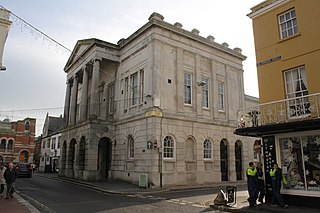
Weymouth Guildhall is a former guildhall at Weymouth, Dorset, England. The building, which was constructed in the 1830s, is a Grade II* listed building.
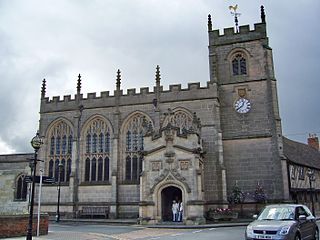
The Guild Chapel of the Holy Cross, Stratford-upon-Avon, Warwickshire is a chapel of 13th century origins. Founded by the Guild of the Holy Cross before 1269, it passed into the control of the town corporation in 1553, when the Guild was suppressed by Edward VI. The chapel stands on Church Street, opposite the site of William Shakespeare's home, New Place, and has historic connections to Shakespeare's family. The chapel was gifted an extensive series of wall-paintings by Hugh Clopton, an earlier owner of New Place, and John Shakespeare, Shakespeare's father, undertook their defacement in the later 1500s. The paintings have recently been conserved.
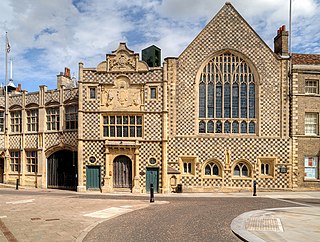
King's Lynn Guildhall, more fully referred to as the Guildhall of the Holy and Undivided Trinity, is a municipal building in Saturday Market Place in King's Lynn, Norfolk. It is a Grade I listed building.
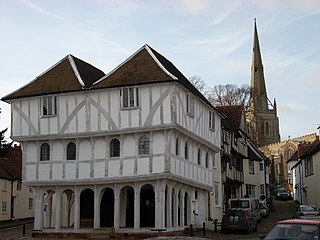
Thaxted Guildhall is a municipal building in Thaxted, Essex, England. It is a Grade I listed building.

Stratford-upon-Avon Town Hall is a municipal building in Sheep Street, Stratford-upon-Avon, Warwickshire. It is a Grade II* listed building.

The Almshouses are a group of grade I listed early-15th century almshouses in Church Street, Stratford-upon-Avon, Warwickshire, England. They adjoin the Guildhall which dates from the same time period. The almshouses still remain in use for their original purpose.

The Guild of the Holy Cross was a medieval religious guild in Stratford-upon-Avon, which was created in 1269, and abolished in 1547. Throughout the period of its existence, the guild was a central institution of Stratford's civic and cultural life, which catered for the town's spiritual needs and fulfilled a range of political and social functions. A number of historical buildings associated with the guild still survive today.



















